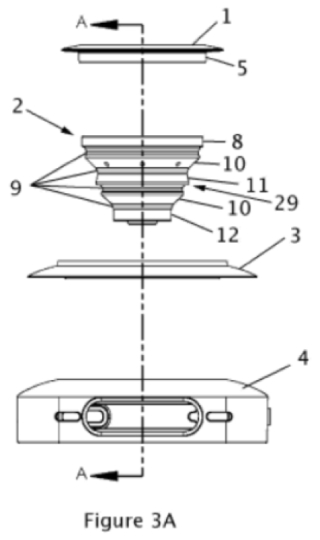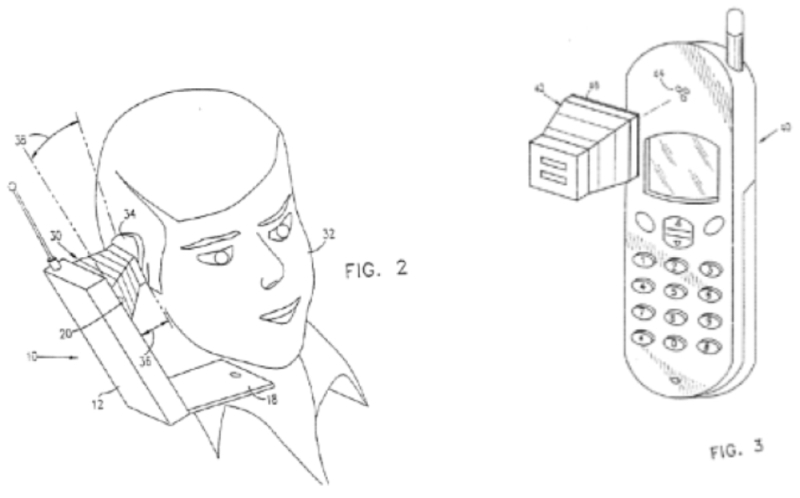Functional Language in Device Claim Ignored for Patentability Purposes
The U.S. Patent and Trademark Office Patent Trial and Appeal Board recently issued a decision indicating that certain claims of a patent directed to the popular PopSockets are invalid. In Quest USA Corp. (Petitioner) v. PopSockets LLC (Patent Owner) (Case IPR2018-00497), the PTAB determined that Quest showed, by a preponderance of the evidence, that claims 9–11, 16, and 17 ("challenged claims") of U.S. Patent No. 8,560,031 are unpatentable.
Quest filed a Petition for inter partes review of claims 9–11, 16, and 17 of the '031 patent based on the five different grounds. Only one is discussed below—namely, claims 9–11, 16, and 17 as being anticipated by UK Patent Application GB 2 316 263 (Grinfas).
The '031 Patent
The '031 patent, entitled "Extending Socket for Portable Media Player," was filed on February 23, 2012. The '031 patent specification describes extending sockets for attaching to the back of a portable media player or media player case.
Figure 3A illustrates a preferred embodiment of the socket in an accordion shape in its expanded configuration.

Of the challenged claims, claims 9 and 16 are independent, and claim 9 is representative and reproduced below.
9. A socket for attaching to a portable media player or to a portable media player case, comprising:
a securing element for attaching the socket to the back of the portable media player or portable media player case; and
an accordion forming a tapered shape connected to the securing element, the accordion capable of extending outward generally along its [axis] from the portable media player and retracting back toward the portable media player by collapsing generally along its axis; and
a foot disposed at the distal end of the accordion.
Overview of Grinfas
Grinfas relates to a collapsible sound conduit for attaching to a cellular telephone earpiece. Grinfas states that a concern had arisen regarding the safety of users of portable hand-held cellular telephones, namely with regard to radiation emitted by such telephones. To address such concern, Grinfas discloses a collapsible sound conduit placed between the telephone's earpiece and the user's ear, for enabling a user to maintain the telephone at a spaced distance away from the user's head to reduce radiation exposure while nevertheless maintaining an acceptable level of hearing.
Grinfas discloses that the collapsible sound conduit can be "attached to either the telephone or the carrying case," by bonding or fastening.
Figure 2 of Grinfas (shown below), shows an example of the collapsible sound conduit in use. Figure 3 of Grinfas (shown below) shows a cellular telephone 40 and collapsible sound conduit 42, wherein conduit 42 includes adhesive pad 46 for bonding the conduit to earpiece 44 of telephone 40.
 Petitioner identified the collapsible sound conduit as the asserted socket for attaching to a portable media player or portable media player case.
Petitioner identified the collapsible sound conduit as the asserted socket for attaching to a portable media player or portable media player case.
Patent Owner disputed Petitioner's assertions that Grinfas discloses "a securing element" and "an accordion," as those terms are used in the claim.
The Board found that with regard to the recitation in claim 9 that the socket comprises "a securing element for attaching the socket to the back of the portable media player or portable media player case" ("securing element limitation"), there is no genuine dispute that Grinfas discloses the recited structure, namely "a securing element." However, the parties disputed whether the remaining language, "for attaching the socket to the back of the portable media player or portable media player case," recites 1) functional language that must be given patentable weight, or 2) an intended use that is not limiting.
As the Patent Owner pointed out, Grinfas describes attaching the collapsible sound conduit to the front of the telephone, whereas claim 9 recites a securing element for attaching the socket to the back of a portable media player.
The Board pointed to a number of Federal Circuit decisions, in which the Court stated that in an apparatus claim, "choosing to define an element functionally, i.e., by what it does, carries with it a risk." This is because it is well settled that the recitation of a new intended use for an old product does not make a claim to that old product patentable. This finds support from the notion that an apparatus claim covers what a device is, not what a device does. Thus, "[w]here all structural elements of a claim exist in a prior art product, and that prior art product is capable of satisfying all functional or intended use limitations, the claimed invention is nothing more than an unpatentable new use for an old product." Bettcher Indus., Inc. v. Bunzl USA, Inc., 661 F.3d 629, 654 (Fed. Cir. 2011).
Thus, the Board found that because Grinfas discloses securing structures that are inherently capable of performing the function of attaching the asserted socket to the back of the portable media player, it has supporting disclosure for the limitation "a securing element for attaching the socket to the back of the portable media player or portable media player case."
The Patent Owner argued that the issue is not whether Grinfas' securing structures would adhere the conduit to the back of a phone, but rather was whether Grinfas discloses attaching the conduit to the back of a phone. Therefore, Patent Owner's argument was not about whether Grinfas' securing structures are capable of attaching a conduit to the back of a phone, but rather was about whether Grinfas discloses the function of attaching to the back of a phone. The Patent Owner argued that an expert declaration failed to provide evidence that the claimed function is necessarily present in Grinfas, and that expert testimony, without (additional) evidence is insufficient to establish inherency.
The Board disagreed that the Petitioner failed to establish inherency. In particular, the Board disagreed that the Petitioner is required to show that the claimed function is actually performed or must be performed when the full structure is described.
Thus, despite the cited art failing to describe the full use of the structure, as recited in the claim, and also being directed to a clearly different use altogether, it was found to anticipate the claim because the structure in Grinfas was capable of performing the recited use.
As a result, because Grinfas discloses a securing element inherently capable of being attached to the back of a portable media player, the Board found that Grinfas discloses the securing element limitation. Thus, the Board determined that Petitioner demonstrated, by a preponderance of the evidence, that claim 9 is anticipated by Grinfas.
Panel: Administrative Patent Judges Zado, Kaiser, and Margolies
Final Written Decision by Administrative Patent Judge Zado